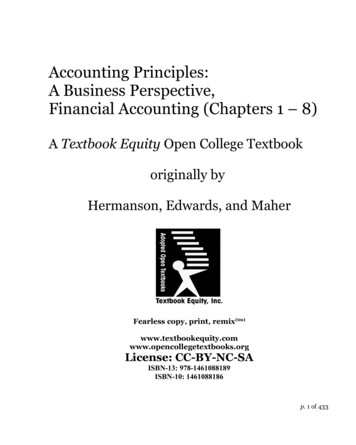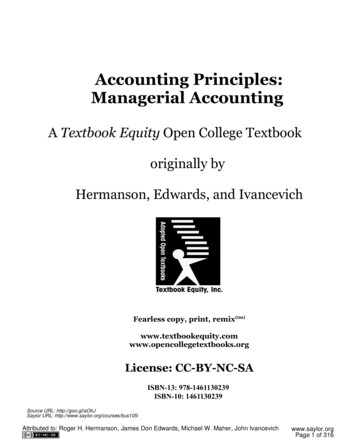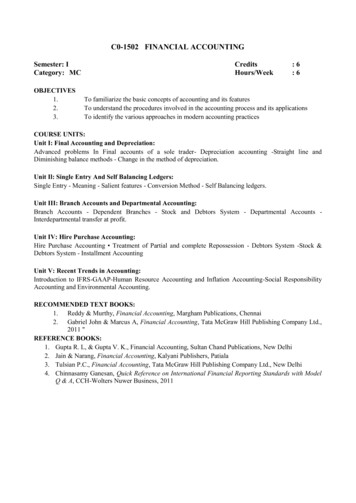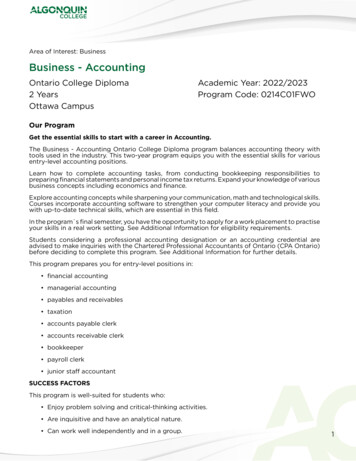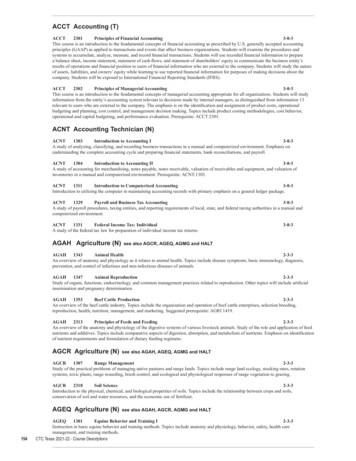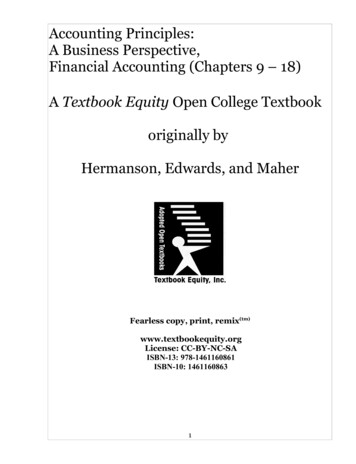
Transcription
Accounting Principles:A Business Perspective,Financial Accounting (Chapters 9 – 18)A Textbook Equity Open College Textbookoriginally byHermanson, Edwards, and MaherFearless copy, print, remix(tm)www.textbookequity.orgLicense: CC-BY-NC-SAISBN-13: 978-1461160861ISBN-10: 14611608631
About This PublicationSimply put, you may copy, print, redistribute, and re-purpose this textbook or parts of thistextbook provided that you give attribution (credit) to Textbook Equity, and providedthat any derivative work has the same Creative Commons license (CC-BY-NC-SA). That’sit.Textbook Equity, in turn, provides attribution, with thanks, to the Global Text Project,who provided the source textbook.Consistent with it’s strategic mission to provide free and low-cost textbooks, this isTextbook Equity’s derivative work based on “Accounting Principles: A BusinessPerspective, First Global Text Edition, Volume 1, Financial Accounting”, utilizing thepermissions granted by it’s Creative Commons license. Global Text Project nor the originalauthors endorse or are responsible in any way for this printing or it’s contents.Textbook Provenance (1998 - 2011)1998 EditionAccounting: A Business Perspective (Irwin/Mcgraw-Hill Series in Principles ofAccounting) [Hardcover] Roger H. Hermanson (Author), James Don Edwards (Author),Michael W. Maher (Author) Eighth EditionHardcover: 944 pagesPublisher: Richard D Irwin; 7 Sub edition (April 1998)Language: EnglishISBN-10: 0075615851ISBN-13: 978-0075615859Product Dimensions: 11.1 x 8.7 x 1.8 inchesCurrent Hardbound Price 140.00 (Amazon.com)2010 Editions (http://globaltext.terry.uga.edu/books/)Global Text Project Conversion to Creative Commons License CC-BY“Accounting Principles: A Business Perspective First Global Text Edition, Volume 1Financial Accounting”, Revision Editor: Donald J. McCubbrey, PhD.PDF Version, 817 pages, Free Download“Accounting Principles: A Business Perspective First Global Text Edition, Volume 2Managerial Accounting”, Revision Editor: Donald J. McCubbrey, PhD.PDF Version Volume 2, 262 pages, Free Download2011 Editions (http://textbookequity.org)Textbook Equity publishes this soft cover version using a the CC-BY-NC-SA license. Theydivided Volume 1 into two sections to fit paperback publishing requirements and madeother formatting changes. No content changes were made to Global Text’s version.Versions available at the Open College Textbook repository:2
PDF Version, Section 1 of Volume 1 (Chapters 1 – 8), 436 pages, Free Download Textbook Equity Paperback, Volume 1 Financial Accounting (Chapters 1 – 8), 436pages PDF Version, Volume 1 Financial Accounting (Chapters 9 – 18), Free Download Textbook Equity Paperback, Volume 1 Financial Accounting (Chapters 9 – 18) PDF Version Volume 2, (Chapters 19 – 26), Free Download Textbook Equity Paperback, Volume 2 Managerial Accounting (Chapters 19 – 24)For original author information and acknowledgments seetextbookequity.orgRevisions:Updated 4/2015: corrected spellings and website names.3
Table of Contents9 Receivables and payables.119.1 Learning objectives. 119.2 A career in litigation support. 119.3 Accounts receivable. 139.4 Current liabilities. 269.5 Notes receivable and notes payable.359.6 Short-term financing through notes payable.429.7 Analyzing and using the financial results—Accounts receivable turnover.459.8 Key terms. 509.9 Self test. 529.10 Questions. 549.11 Exercises. 569.12 Problems. 589.13 Alternate problems. 619.14 Beyond the numbers—Critical thinking.639.15 Using the Internet—A view of the real world.659.16 Answers to self test. 6610 Property, plant, and equipment.6810.1 Learning objectives. 6810.2 A company accountant's role in managing plant assets.6810.3 Nature of plant assets. 6910.4 Initial recording of plant assets.7110.5 Depreciation of plant assets.7710.6 Subsequent expenditures (capital and revenue) on assets.9010.7 Subsidiary records used to control plant assets.9410.8 Analyzing and using the financial results—Rate of return on operating assets.9710.9 Key terms. 10110.10 Self-test. 10210.11 Exercises. 1064
10.12 Problems. 10910.13 Alternate problems. 11210.14 Beyond the numbers—Critical thinking.11510.15 Using the Internet—A view of the real world.11810.16 Answers to self-test. 11811 Plant asset disposals, natural resources, and intangible assets.12011.1 Learning objectives. 12011.2 A company accountant's role in measuring intangibles.12011.3 Disposal of plant assets. 12211.4 Sale of plant assets. 12211.5 Natural resources. 13311.6 Intangible assets. 13811.7 Analyzing and using the financial results—Total assets turnover.14711.8 Key terms. 15511.9 Self-test. 15611.10 Problems. 16211.11 Alternate problems. 16611.12 Beyond the numbers-Critical thinking.17011.13 Using the Internet—A view of the real world.17311.14 Answers to self-test. 17312 Stockholders' equity: Classes of capital stock.17512.1 Learning objectives. 17512.2 The accountant as a corporate treasurer.17512.3 The corporation. 17612.4 Analyzing and using the financial results—Return on average common stockholders'equity. 20212.5 Key Terms. 20912.6 Self-test. 21212.7 Exercises. 21512.8 Problems. 21612.9 Alternate problems. 22012.10 Beyond the numbers—Critical thinking.2255
12.11 Using the Internet—A view of the real world.22712.12 Answers to self-test. 22813 Corporations: Paid-in capital, retained earnings, dividends, and treasurystock. 23013.1 Learning objectives. 23013.2 The accountant as a financial analyst.23013.3 Paid-in (or contributed) capital.23113.4 Paid-in capital—Stock dividends.23213.5 Paid-in capital—Treasury stock transactions.23313.6 Paid-in capital—Donations.23313.7 Retained earnings. 23313.8 Paid-in capital and retained earnings on the balance sheet.23413.9 Retained earnings appropriations.24413.10 Statement of retained earnings.24613.11 Statement of stockholders' equity.24713.12 Treasury stock. 24813.13 Net income inclusions and exclusions.25313.14 Analyzing and using the financial results—Earnings per share and price-earningsratio. 25913.15 Key terms. 26513.16 Self-test. 26713.17 Exercises. 27113.18 Problems. 27313.19 Alternate problems. 27813.20 Beyond the numbers—Critical thinking.28213.21 Using the Internet—A view of the real world.28613.22 Answers to self-test. 28614 Stock investments.28814.1 Learning objectives. 28814.2 The role of accountants in business acquisitions.28814.3 Cost and equity methods. 29014.4 Accounting for short-term stock investments and for long-term stock investments ofless than 20 percent . 2916
14.5 Cost method for short-term investments and for long-term investments of less than20 percent . 29114.6 The equity method for long-term investments of between 20 percent and 50 percent. 29714.7 Reporting for stock investments of more than 50 percent .29814.8 Consolidated balance sheet at time of acquisition.30214.9 Accounting for income, losses, and dividends of a subsidiary.30814.10 Consolidated financial statements at a date after acquisition.30914.11 Uses and limitations of consolidated statements.31314.12 Analyzing and using the financial results—Dividend yield on common stock andpayout ratios. 31414.13 Key terms. 32114.14 Self-test. 32214.15 Exercises. 32514.16 Problems. 32714.17 Alternate problems. 33114.18 Beyond the numbers—Critical thinking.33414.19 Using the Internet—A view of the real world.33614.20 Answers to self-test. 33615 Long-term financing: Bonds.33715.1 Learning objectives. 33715.2 The accountant's role in financial institutions.33815.3 Bonds payable. 33915.4 Comparison with stock. 34015.5 Selling (issuing) bonds. 34015.6 Bond prices and interest rates.34815.7 Redeeming bonds payable. 35915.8 Analyzing and using the financial results—Times interest earned ratio.36515.9 Appendix: Future value and present value.37015.10 Demonstration problem. 37715.11 Solution to demonstration problem.37715.12 Key terms. 37815.13 Self-test. 3807
15.14 Exercises. 38315.15 Problems. 38515.16 Alternate problems. 38715.17 Beyond the numbers—Critical thinking.38915.18 Using the Internet—A view of the real world.39215.19 Answers to self-test. 39316 Analysis using the statement of cash flows.39416.1 Learning objectives. 39416.2 A career in external auditing.39416.3 Purposes of the statement of cash flows.39616.4 Uses of the statement of cash flows.39716.5 Information in the statement of cash flows.39816.6 Cash flows from operating activities.40016.7 Steps in preparing statement of cash flows.40416.8 Analysis of the statement of cash flows.41216.9 Liquidity and capital resources.41216.10 Analyzing and using the financial results—Cash flow per share of common stock,cash flow margin, and cash flow liquidity ratios.42116.11 Appendix: Use of a working paper to prepare a statement of cash flows.42416.12 Key terms. 43116.13 Self-test. 43216.14 Questions. 43416.15 Exercises. 43516.16 Problems. 43716.17 Alternate problems. 44616.18 Management's discussion and analysis - Capital.44916.19 Management's discussion and analysis - Financial*.45316.20 Beyond the numbers—Critical thinking.45716.21 Using the Internet—A view of the real world.46116.22 Answers to self-test. 46217 Analysis and interpretation of financial statements.46317.1 Learning objectives. 4638
17.2 Accountants as investment analysts.46317.3 Objectives of financial statement analysis.46417.4 Sources of information.46717.5 Horizontal analysis and vertical analysis: An illustration.46917.6 Trend percentages. 47317.7 Ratio analysis. 47517.8 Understanding the learning objectives.50517.9 Demonstration problem .50817.10 Solution to demonstration problem.51017.11 Key terms. 51117.12 Self-test. 51317.13 Exercises. 51717.14 Problems. 51917.15 Alternate problems. 52717.16 Beyond the numbers – Critical thinking.53417.17 Using the Internet—A view of the real world.53717.18 Answers to self-test. 53818 Managerial accounting concepts/job costing.54018.1 Learning objectives. 54018.2 A manager's perspective. 54018.3 Compare managerial accounting with financial accounting.54218.4 Merchandiser and manufacturer accounting: Differences in cost concepts.54318.5 Financial reporting by manufacturing companies.54818.6 The general cost accumulation model.55218.7 Job costing. 55518.8 Predetermined overhead rates.56318.9 Appendix: Variable versus absorption costing.56718.10 Demonstration problem. 57018.11 Solution to demonstration problem.57118.12 Key terms. 57318.13 Self-test. 57418.14 Questions. 5779
18.15 Exercises. 57918.16 Problems. 58118.17 Alternate problems.58618.18 Beyond the numbers—Critical thinking.58818.19 Using the Internet—A view of the real world.59218.20 Answers to self-test. 59410
9 Receivables and payables9.1 Learning objectivesAfter studying this chapter, you should be able to: Account for uncollectible accounts receivable under the allowance method. Record credit card sales and collections. Define liabilities, current liabilities, and long-term liabilities. Define and account for clearly determinable, estimated, and contingentliabilities. Account for notes receivable and payable, including calculation of interest. Account for borrowing money using an interest-bearing note versus a noninterest-bearing note. Analyze and use the financial results—accounts receivable turnover and thenumber of days' sales in accounts receivable.9.2 A career in litigation supportWhat is litigation support? It does not mean working in an attorney's office. Itinvolves assisting legal counsel in attempting to gain favorable verdicts in a court oflaw. Persons involved in litigation support generally work for a public accounting firm,a consulting firm, or as a sole proprietor or in partnership with others. An experiencedlitigation support person can expect to earn an income well into six figures.Litigation support in a broad sense encompasses fraud auditing, valuation analysis,investigative accounting, and forensic accounting. The practice of litigation supportinvolves assisting legal counsel in such things as product liability disputes, shareholderdisputes, contract breaches, and major losses reported by entities. These investigationsrequire the accountant to gather and evaluate evidence to assess the integrity anddollar amounts surrounding the aforementioned situations.The accountant can be, and often is, requested to serve as an expert witness in acourt of law. This experience requires knowledge of accounting and auditing inaddition to possessing good communication skills, appropriate credentials, relevant11
experience, and critical information that could result in successful resolution of theissue.What kind of person pursues litigation support as a career? It takes a very specialindividual. The person must be part accountant, part auditor, part lawyer, and partskilled businessperson. An undergraduate accounting degree, an MBA, and a lawdegree would be the perfect educational background needed for such a career. Manyuniversities offer a combined MBA/JD program. Such a program fulfills the graduateneeds of the litigation support person.In addition to the degree, work experience in the business sector is essential. Acareer in public accounting, industry, or with a government agency would serve asvaluable experience in pursuing a career in litigation support.Much of the growth of business in recent years is due to the immense expansion ofcredit. Managers of companies have learned that by granting customers the privilege ofcharging their purchases, sales and profits increase. Using credit is not only aconvenient way to make purchases but also the only way many people can own highpriced items such as automobiles.This chapter discusses receivables and payables. For a company, a receivab
Financial Accounting (Chapters 9 - 18) A Textbook Equity Open College Textbook originally by Hermanson, Edwards, and Maher Fearless copy, print, remix(tm) www.textbookequity.org . Volume 1 Financial Accounting (Chapters 9 - 18) PDF Version Volume 2, (Chapters 19 - 26), Free Download



